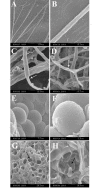Interference and Mechanism of Dill Seed Essential Oil and Contribution of Carvone and Limonene in Preventing Sclerotinia Rot of Rapeseed
- PMID: 26133771
- PMCID: PMC4489822
- DOI: 10.1371/journal.pone.0131733
Interference and Mechanism of Dill Seed Essential Oil and Contribution of Carvone and Limonene in Preventing Sclerotinia Rot of Rapeseed
Abstract
This study aimed to evaluate the inhibitory effects of dill (Anethum graveolens L.) seed essential oil against Sclerotinia sclerotiorum and its mechanism of action. The antifungal activities of the two main constituents, namely carvone and limonene, were also measured. Mycelial growth and sclerotial germination were thoroughly inhibited by dill seed essential oil at the 1.00 μL/mL under contact condition and 0.125μL/mL air under vapor condition. Carvone also contributed more than limonene in inhibiting the growth of S. sclerotiorum. Carvone and limonene synergistically inhibited the growth of the fungus. In vivo experiments, the essential oil remarkably suppressed S. sclerotiorum, and considerable morphological alterations were observed in the hyphae and sclerotia. Inhibition of ergosterol synthesis, malate dehydrogenase, succinate dehydrogenase activities, and external medium acidification were investigated to elucidate the antifungal mechanism of the essential oil. The seed essential oil of A. graveolens can be extensively used in agriculture for preventing the oilseed crops fungal disease.
Conflict of interest statement
Figures







Similar articles
-
In vitro evaluation of dill seed essential oil antifungal activities to control Zymoseptoria tritici.Commun Agric Appl Biol Sci. 2013;78(3):489-95. Commun Agric Appl Biol Sci. 2013. PMID: 25151824
-
Composition, quality control, and antimicrobial activity of the essential oil of long-time stored dill (Anethum graveolens L.) seeds from Bulgaria.J Agric Food Chem. 2003 Jun 18;51(13):3854-7. doi: 10.1021/jf030004y. J Agric Food Chem. 2003. PMID: 12797755
-
Antioxidant activity of Anethum graveolens L. essential oil constituents and their chemical analogues.J Food Biochem. 2019 Apr;43(4):e12782. doi: 10.1111/jfbc.12782. Epub 2019 Feb 1. J Food Biochem. 2019. PMID: 31353585
-
Essential Oils, Part III: Chemical Composition.Dermatitis. 2016 Jul-Aug;27(4):161-9. doi: 10.1097/DER.0000000000000193. Dermatitis. 2016. PMID: 27427817 Review.
-
Biosynthesis and Biotechnology of High-Value p-Menthane Monoterpenes, Including Menthol, Carvone, and Limonene.Adv Biochem Eng Biotechnol. 2015;148:319-53. doi: 10.1007/10_2014_289. Adv Biochem Eng Biotechnol. 2015. PMID: 25618831 Review.
Cited by
-
D-carvone induced ROS mediated apoptotic cell death in human leukemic cell lines (Molt-4).Bioinformation. 2021 Jan 31;17(1):171-180. doi: 10.6026/97320630017171. eCollection 2021. Bioinformation. 2021. PMID: 34393434 Free PMC article.
-
Nanoemulsion of Dill essential oil as a green and potent larvicide against Anopheles stephensi.Environ Sci Pollut Res Int. 2018 Mar;25(7):6466-6473. doi: 10.1007/s11356-017-0822-4. Epub 2017 Dec 17. Environ Sci Pollut Res Int. 2018. PMID: 29250730
-
Evaluation of Antibacterial Activity Expression of the Hinokitiol/Cyclodextrin Complex Against Bacteria.ACS Omega. 2020 Oct 16;5(42):27180-27187. doi: 10.1021/acsomega.0c03222. eCollection 2020 Oct 27. ACS Omega. 2020. PMID: 33134678 Free PMC article.
-
Limonene formulation exhibited potential application in the control of mycelial growth and deoxynivalenol production in Fusarium graminearum.Front Microbiol. 2023 Mar 23;14:1161244. doi: 10.3389/fmicb.2023.1161244. eCollection 2023. Front Microbiol. 2023. PMID: 37125209 Free PMC article.
-
Lignin Nanoparticles with Entrapped Thymus spp. Essential Oils for the Control of Wood-Rot Fungi.Polymers (Basel). 2023 Jun 17;15(12):2713. doi: 10.3390/polym15122713. Polymers (Basel). 2023. PMID: 37376359 Free PMC article.
References
-
- Jones D, Watson D (1969) Parasitism and lysis by soil fungi of Sclerotinia sclerotiorum (Lib.) de Bary, a phytopathogenic fungus. Nature 224: 287–288.
-
- Hu X, Daniel PR, Mulan J, Zhang Y (2005) Decreased incidence of disease caused by Sclerotinia sclerotiorum and improved plant vigor of oilseed rape with Bacillus subtilis Tu-100. Appl Microbiol Biotechnol 68: 802–807. - PubMed
-
- Vinod K, Mathela CS, Geeta T, Darshan S (2014) Antifungal activity of Nepeta elliptica Royle ex Benth. oil and its major constituent (7R)- trans, trans-nepetalactone: A comparative study. Ind Crops Products 55: 70–74.
Publication types
MeSH terms
Substances
LinkOut - more resources
Full Text Sources
Other Literature Sources

